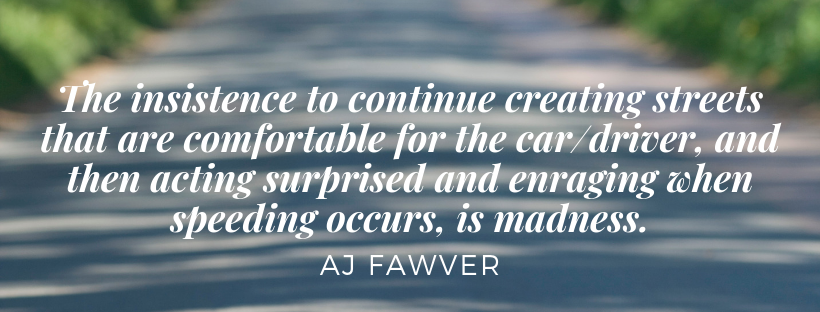
This is a monthly blog by AJ Fawver. She’ll share her perspectives on land use, planning, and community development in this series. Learn more about AJ from her GovLove interview! Read the whole series here.
Earlier this week, in putting together a presentation focusing on the various types of thoroughfares involved in a master thoroughfare plan, I was reminded that there is intentional thought about this idea of a hierarchy within a transportation network.
That said, look around at the cities being shaped and built around us. Take my home state as an example. If high speed roads (for funneling large amounts of traffic) and streets (for accessing neighborhoods & leading us to places) have different purposes, different definitions, and different names…why are they being built in such a similar fashion?
Taking a drive to get to know an area is now a very different activity in many cities than it used to be. First, you’re spending a lot of time figuring out what through streets exist in a sea of cul-de-sacs.
Second, streets are so wide that a diverted flight from the nearest airport could land comfortably, but speed limit signs stand prominently.
Third, you’re bound to happen upon speed humps that appear with little warning. What do all of these things have in common? They’re reactions to safety issues.
What if cities took a more proactive approach? What if safety was the first thought in designing streets? If your immediate response is something like, “but cul-de-sacs are safe…” think about safety in a larger context.
For example, read Charles Montgomery’s Happy City: Transforming Our Lives Through Urban Design, in which he explains that people who live in neighborhoods “…with latticeworklike streets actually drive 26 percent fewer miles than people in the cul-de-sac forest.” Think about the ability for emergency services to have more than one way into an area.
William H. Lucy and David L. Phillips address this in “The Cul-de-Sac Safety Myth: Housing Markets and Settlement Patterns”, advising as to the artificial nature of the safety promised by these dead-end streets.
Do we really believe that wider streets provide safety? Do we accept as fact that speed limit signs really limit speeds, when the car rules the road?
The insistence to continue creating streets that are comfortable for the car/driver, and then acting surprised and enraging when speeding occurs, is madness.
Let us also make room for pedestrians, allowing them the same courtesies. Remember Jane Jacob’s “eyes on the street”? This social presence is rendered largely impossible when every street (cul-de-sacs included) functions at higher speeds than appropriate.
The presence of speed humps is questionable on many of the streets I’ve seen, where the pavement width is so broad that cars can virtually avoid them. How effective are they?
I have also (repeatedly!) heard the argument in cities without sidewalk requirements that streets are built wider “so people can walk in them”. Creating an environment that encourages vehicular speeding is the last place anyone should be walking.
In reality, the bigger discussion of safety should include acknowledgement that much larger percentages of emergencies along streets are crashes and pedestrian/cyclist injuries, which are far less damaging (and fatal) at lower speeds.
Setting speed limits is not going to get us there. When building and shaping your city, don’t dismiss street design and subdivision regulations as simply engineering tools; safety matters to everyone. It is both a social issue and a livability consideration; it should also be a larger discussion at a municipal level.
Ultimately, do we believe our residents and their children are safer with these reactive measures in place trying to convince drivers to slow down, or when we create streets that necessitate drivers to do so?
Top down, the philosophies on this topic are beginning to change around the country; unfortunately, that change is not happening at a rate remotely comparable to that of the cars speeding down these streets.
For additional resources, check these out:
- “2 Photos Reveal Why the Key to Slowing Traffic is Street Design, Not Speed Limits” – Strong Towns,
- “Happy City: Transforming Our Lives Through Urban Design” – Charles Montgomery
- “Urban Street Design Guide” – National Association of City Transportation Officials
- “Wide Residential Streets Are Dangerous. Why Are They So Common?” – Angie Schmitt for Streetsblog USA,
